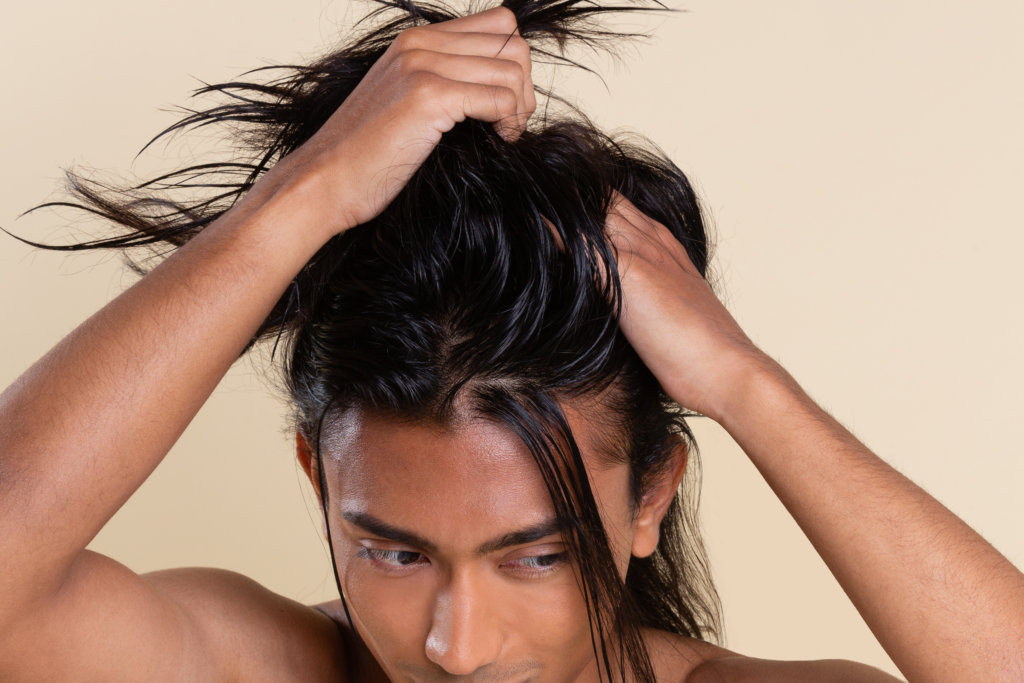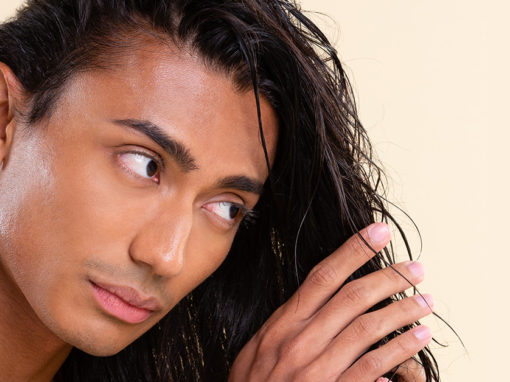Hair damage is a common issue in today’s world. Many individuals have dry, unmanageable, or frizzy hair. While damaged hair isn’t life-threatening or physically painful, ignoring it may ultimately lead to hair loss.
We discuss the many causes of hair damage and how to recognise the signs of possible damage in this article. Understanding the indications of damage enables repair so that your hair returns to a luscious, healthy condition.
How do you identify damaged hair?
There are three layers in each hair strand:
1. The tender medulla, which is the core.
2. The cortex is the primary component of the hair that encircles the medulla.
3. The cuticle is a thick, protective coating surrounding the shaft.
The core of your hair may become vulnerable to damage when external elements like heat, chemicals, or the environment erode the hair cuticle that serves as protection. To detect if you suffer from hair damage, look out for these red flags:
- Dry hair
- Lifeless hair
- Dull hair
- Brittle hair
- Hair that falls very easily
- Split ends
- Thin hair
- Unmanageable hair
- Frizzy hair
- Rough hair
Tender, loving care is required to restore hair to good health if it’s displaying any of these characteristics.
Types of hair damage
Thankfully, hair damage can be repaired using the correct hair care products and treatments. However, to ensure you pick the right products and treatment, you must identify the type of hair damage you have.
Thinning or hair loss
Hair thinning and hair loss could result from harsh chemicals, poor hair care habits, malnourishment, crash dieting, stress, and medical disorders such as hormone imbalance.
However, male pattern baldness (MPB), also known as androgenetic alopecia, is a frequent cause of hair loss in older men. In this condition, the hormone dihydrotestosterone (DHT) weakens and shrinks the hair follicles, ultimately diminishing their capacity to generate hair.
Thinning and hair loss treatment
For effective hair loss treatment, it would be best to speak to a doctor to identify the underlying problem. A blood test might also show any nutritional or hormonal deficiencies. Medications such as finasteride that reduces the production of DHT (dihydrotestosterone hormone which causes hair loss) might be used once the reason is identified.
To help nourish hair from within, maintain a healthy diet that includes vitamins and minerals. You can use vitamin pills and topical treatments to restore exterior damage.
Split ends
Split ends result from depleting the hair of its natural oils, the tips split into two or more heads, and the strand feels coarse to the touch. In addition, they can break the whole hair shaft if ignored.
Split ends treatment
Here are a few tips that can help keep split ends at bay:
- Apply nourishing and restoring serums to hydrate the split hair ends as a temporary fix
- To prevent split ends from reappearing, trim your hair every month
- When sleeping, use a satin or silk pillowcase to avoid dehydrating hair
- Avoid towel-drying your hair
- Avoid combing wet hair
- Use heat styling equipment sparingly
- Avoid using strong chemicals (ammonia dyes, relaxers)
Colour damage
While colouring your hair is fun, it can cause significant damage. Hydrogen peroxide, a bleaching agent, and ammonia are ingredients in hair dyes which open hair cuticles and alter hair structure leading to colour damage.
Colour damage hair treatment
The following techniques may help restore colour-damaged hair:
- Space out colour treatments
- Use shampoos and conditioners safe for coloured hair, they protect colour from fading while being kind to hair
- Avoid sun exposure
- Apply hair masks once a week and pamper your hair with a spa treatment
- Always use a hair dye without ammonia
Chemical damage
Chemical damage occurs when the hair’s internal structure changes due to procedures that use harsh chemicals, such as semi-permanent hair procedures such as perming, hair rebonding, and keratin straightening. As a result, chemical damaged hair may be brittle, dry, porous, and delicate.
Chemical damage hair treatment
Follow these methods to undo chemical damage:
- Wash your hair regularly with sulphate-free shampoos
- Deep condition your hair with keratin protein conditioners to promote healing
- Apply hair masks every week and go for monthly hair spa treatments
- Use leave-in conditioners
- Opt for a hair dye without ammonia
- Avoid multiple colour treatments in close succession
Heat damage
Heat-styling tools such as flat or curling irons and blow dryers can damage hair because of its continuous exposure to high temperatures opens the cuticles. It can leave hair feeling dehydrated and frayed.
Heat damage hair treatment
Here’s how to can fix heat-damaged hair:
- A protein hair treatment once a week may help restore health to heat-damaged hair
- A warm olive oil treatment helps replenish heat damaged hair. Apply it on freshly washed, towel-dried hair, and leave it on for an hour before rinsing thoroughly
- Use cool or lukewarm water to wash your hair
- Use a mild shampoo and wash your hair gently
- After a shower, a leave-in conditioner will aid in sealing moisture for all-day hair moisturisation
- Avoid high-temperature settings on hair styling tools to minimise damage
Mechanical damage
Mechanical damage occurs when hair is roughly handled. For example, pulling, tugging, and rigorous towel drying. Another factor contributing to mechanical damage is combing through damp hair. In addition to wet hair being fragile, hair cuticles may open up after towel drying.
Besides this, cotton pillowcases are an underreported factor in mechanical hair damage. These pillows have long fibres that pull your hair and excellent absorption capacity that takes away moisture from your hair, which increases friction.
Mechanical damage hair treatment
These tips can help prevent mechanical damage:
- Instead of using a towel to dry your hair, use an old, soft t-shirt
- Be gentle when washing and brushing your hair
- Whenever feasible, let your hair air dry or use a diffuser
- Avoid using brushes or combs with plastic or other synthetic bristles
- To detangle hair easily, use a serum or hair oil
- Switch to silk or satin pillowcases for sleeping instead of cotton ones
Hard water damage
Numerous calcium, magnesium, and silica minerals are present in hard water.
These elements cause a PH imbalance that makes your hair dry and brittle. In addition, it damages hair follicles, ultimately leading to hair loss.
Hard water damage hair treatment
These approaches should work to revive hair damaged by hard water:
- Use a nutrient-dense hair mask at least twice weekly to rehydrate and restore hair lustre
- Wash your hair weekly with a good quality chelating or clarifying shampoo to remove the mineral buildup from hard water
- A leave-in conditioner can help restore lustre and softness
- An apple cider vinegar rinse can restore pH balance
- Installing a water softener to eliminate all the minerals from hard water is the most straightforward approach to prevent further hard water damage
.
Sun damage
Sun damage is one type of hair damage most individuals are clueless about. The sun’s ultraviolet A and ultraviolet B rays can make your hair parched, lifeless, and fragile.
The effects of UV or sun damage are more evident in coloured hair. This is because regular sun exposure may quickly diminish your hair colour.
Sun damage hair treatment
Thankfully, UV damage can be repaired with these techniques.
- A hair trim is a jump-start
- Use sun-damaged hair treatment shampoo, conditioner, and style products
- Use a nutrient-rich hair mask every week to rehydrate hair
- Apply hair serum and avoid using heat styling equipment until hair is restored to normal
- Spritz UV-blocking hair mist on your hair
- To prevent further damage, wear a cap or use an umbrella on extremely sunny days or at midday
- Use shampoos with UV filters that prevent discolouration if you have coloured hair
Overstressed hair
Stress can significantly affect hair health. It causes dry and brittle hair, which causes breakages and, ultimately, hair loss.
Overstressed hair treatment
Following these tips can salvage overstressed hair and prevent further damage.
- Eating nutritious food guarantees that your hair receives the nutrients it needs to remain healthy
- Be gentle when washing, drying, and combing your hair
- Use hair moisturisers with proteins, aloe vera, glycerol, and panthenol to keep it hydrated
- Avoid styling your hair or using heated equipment on it
- Include a vitamin supplement in your diet
- If you have split ends, get a haircut

How to protect your hair?
Following these guidelines can help you protect your hair; as they say: prevention is better than cure.
- Wash your hair regularly
- Select chemical-free shampoos
- Use conditioner according to the instructions provided
- Air dry instead of using a blow dryer
- Oil your hair regularly
- Use a wooden comb with wide teeth
- Trim your hair regularly
- Drink more water
- Eat well-balanced meals
- Wear caps when out in the sun
- Dry your hair with an old, soft t-shirt
Conclusion
Good hair care is essential since it helps you feel confident and happy.
This article was written to assist you in identifying the issue with your hair and discovering a solution for it. Simply put, it indicates that your hair deserves some tender loving care, especially if you’re subjecting it to stress.
This article is for informational purposes only and does not constitute medical advice. The information contained herein is not a substitute for and should never be relied upon for professional medical advice. If you’re experiencing hair loss, our experts at andSons can provide an online assessment of your hair damage and recommend an appropriate treatment plan.
Take a look at the following products from andSons Malaysia to prevent/treat hair damage in men:


